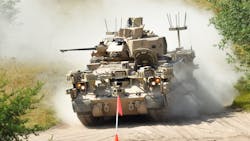Persistent Systems to provide networking communications to help manned and unmanned vehicles work together
NEW YORK – U.S. Army needed secure communications to help enable soldiers to work together with unmanned vehicles. They found their solution from Persistent Systems LLC in New York.
Persistent Systems officials have announced that the Army Combat Capabilities Development Command C5ISR Center at Aberdeen Proving Ground, Md., has awarded the company a $5.4 million contract to develop Protected Communications for Manned-Unmanned Teams (MUM-T).
Army officials say they envision a next-generation optionally manned fighting vehicle (OMFV) that can network with as many as four unmanned remote combat vehicles (RCVs), sensors, and weapons. In turn the Army will network these optionally manned vehicles with the broader force and command structure.
For that to happen, these manned-unmanned teams will need a robust, secure, and high-throughput communications network.
“The Army wants RCVs that can be remotely operated in groups over very long distances, in cities, forests, and open terrain,” says Brian Soles, vice president of business development at Persistent. “These manned-unmanned teams also will have to deal with the threat of enemy hacking and jamming.”
The Persistent Systems MPU5 with its Wave Relay mobile ad hoc networking (MANET) radio was selected previously by the Next Generation Combat Vehicle cross functional team (NGCV-CFT) and the Ground Vehicle Systems Center (GVSC) as the MANET network of choice for RCV Phase 1 and has been under evaluation by the U.S. Army for over a year.
Persistent's MPU5 forms a scalable, peer-to-peer network that does not rely on external communications infrastructure to operate or run through a vulnerable central node.
The MPU5 already has been deployed on several unmanned vehicles. It has an onboard Android computer that hosts command-and-control and situational awareness software; a 3×3 MIMO configuration with as much as 10 Watts of transmit power; and built-In HD video encoder/decoder to distribute several real-time HD video feeds.
As part of its 14-month-long contract, Persistent is working with the Army C5ISR Center’s Space and Terrestrial Communications Directorate to adapt the MPU5 to meet the anti-jam and cyber hardening demands of MUM-T operations.
“The application of the work done under this contract won’t be limited to vehicles,” Soles says. “The idea is to get these same hardened capabilities to dismounted soldiers, which will greatly enhance our ability to operate against more sophisticated adversaries.”
The development initiatives on this contract are in progress, and will continue through 2020. For more information contact Persistent Systems online at www.persistentsystems.com, or the Army Combat Capabilities Development Command C5ISR Center at www.army.mil/article/157832/ccdc_c5isr_center.
